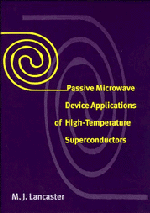Book contents
- Frontmatter
- Contents
- Preface
- Acknowledgements
- 1 Superconductivity at microwave frequencies
- 2 Superconducting transmission lines
- 3 Superconducting cavity resonators
- 4 Microwave measurements
- 5 Superconducting filters
- 6 Superconducting delay lines
- 7 Superconducting antennas
- 8 Signal processing systems
- Appendix 1 The surface impedance of HTS materials
- Appendix 2 Substrates for superconductors
- Appendix 3 Some useful relations
- Index
7 - Superconducting antennas
Published online by Cambridge University Press: 14 September 2009
- Frontmatter
- Contents
- Preface
- Acknowledgements
- 1 Superconductivity at microwave frequencies
- 2 Superconducting transmission lines
- 3 Superconducting cavity resonators
- 4 Microwave measurements
- 5 Superconducting filters
- 6 Superconducting delay lines
- 7 Superconducting antennas
- 8 Signal processing systems
- Appendix 1 The surface impedance of HTS materials
- Appendix 2 Substrates for superconductors
- Appendix 3 Some useful relations
- Index
Summary
Introduction
Antennas can benefit in a number of ways when superconductors are used in their fabrication. This chapter describes areas where superconductors are useful, and in which applications the greatest improvement can be obtained. The obvious application is in the improvement of the radiation efficiency of small antennas and superdirectional arrays. Antennas which are around the size of one wavelength are normally fairly efficient and superconductors cannot help. However, as the size of the antenna is reduced the efficiency reduces due to the increasing dominance of the ohmic losses. In this case superconductors reduce the losses and maintain a reasonable efficiency as the antenna shrinks in size. In principle, it is possible to obtain any directivity from any size of antenna array, and small directive antennas are called superdirective antennas. Again, superdirective antennas are very inefficient and superconductors help to make these a practical proposition, albeit with only a moderate superdirective capability. In addition to the reduction in efficiency, reducing the size of antennas and superdirective antenna arrays also makes matching to a reasonable system impedance increasingly difficult. High-Q matching networks are required, where superconductors also help considerably in performance improvement. As both these antenna types shrink, the Q also increases, restricting the bandwidth over which they can operate, and this now remains the practical limitation to their usefulness. For application purposes, the balance between efficiency or gain and Q needs to be assessed and this chapter addresses this problem in both a general way and also for some specific antennas.
- Type
- Chapter
- Information
- Publisher: Cambridge University PressPrint publication year: 1997



